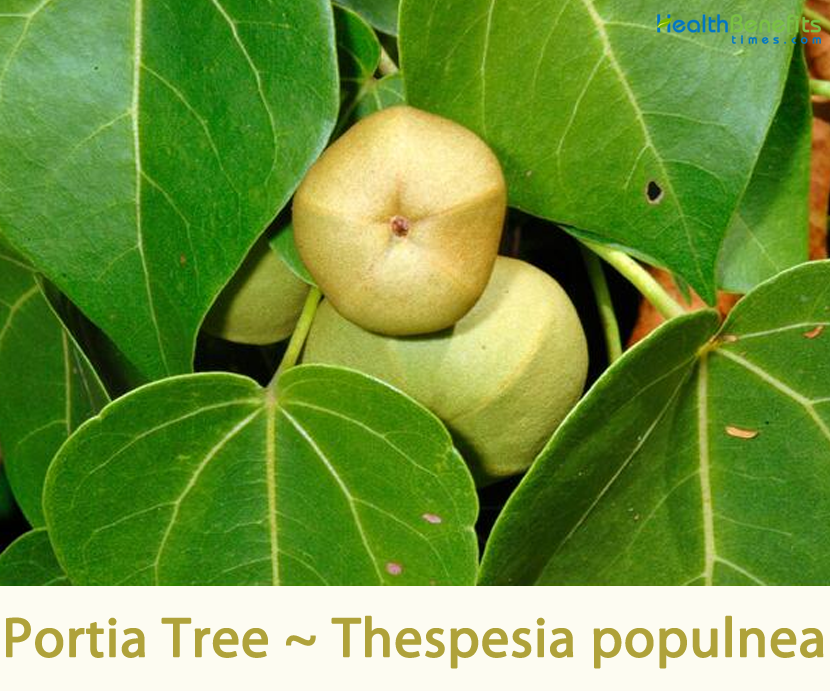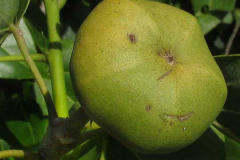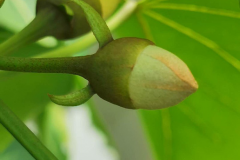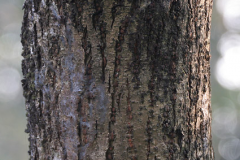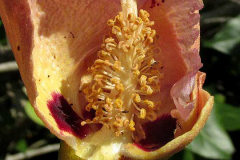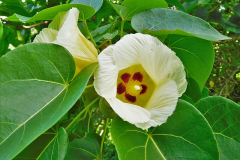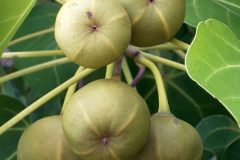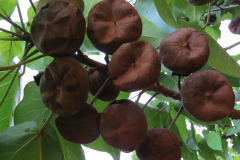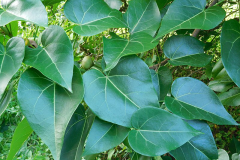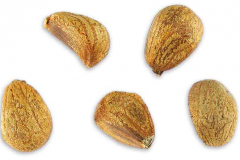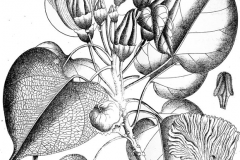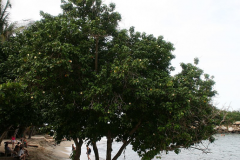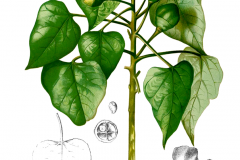| Portia Tree Quick Facts | |
|---|---|
| Name: | Portia Tree |
| Scientific Name: | Thespesia populnea |
| Origin | Tropical Asia, but has been widely planted throughout tropical regions, including Africa, and coastal woodlands in the Caribbean and elsewhere in the Neotropics |
| Colors | Initially yellowish or brownish green when young turning to brown or black when ripe. |
| Shapes | Round to pear-shaped capsules that are flattened, 2–5 cm in diameter |
| Taste | Astringent, Sweet, Sour |
| Health benefits | Support pleurisy, cholera, colic, high fevers, herpes, rheumatism, urinary retention, coughs, influenza, headache, scabies, diabetes, gonorrhea, indigestion, pelvic infection, dysmenorrhea, infertility, secondary amenorrhea and appetite loss |
| Name | Portia Tree |
|---|---|
| Scientific Name | Thespesia populnea |
| Native | Tropical Asia, but has been widely planted throughout tropical regions, including Africa, and coastal woodlands in the Caribbean and elsewhere in the Neotropics |
| Common Names | Indian Tulip Tree, Portia Tree, Pacific Rosewood, Banalo, Dumbla, False rosewood, Gangaraavi, Jogiyarale, Milo, Miro, Mulomulo, Munigangaraavi, Portia tree, Porush, Purau, Seaside mahoe, Umbrella tree, bendy tree, corktree, kalfata, polynesian rosewood, porcher, porché, porlia-tree, seyche, tarapati, tulip tree, valirano, valo, valorao, varo, large-leaved tulip tree, Seychelles rosewood, Aden Apple, Eden Apple, John-Bull tree, false rosewood, thespesia, Annadine, Lagoon tulip-tree, Spanish cork, Majagua, Tree hibiscus |
| Name in Other Languages | American: Samoamilo Assamese: Paraśa pipula (পৰশ পিপল), paras pipal, Bon Kapahi Bangladesh: Shanboloi Bengali: Paraśapipula (পরশপিপুল), paraspipal, Palopipal, Bumbla, Poresh, Gajashuni, pakur, palaspipal Brazil: Bela-sombra, pau-rosa, tespésia Burmese: Jambuu p ne (ဇမ္ဗူပနီ) China: Tong mian (桐棉), San Yang (繖楊), bái jiǎo tóng mián (白脚桐棉), Yang ye xian jin (杨叶肖槿), Lǜ shānhú (绿珊瑚) Dutch: Strandpopulier English: Indian tulip tree, Pacific rosewood, Polynesian rosewood, Portia tree, Seychelles rosewood, Spanish cork, Bendy tree, Cork-tree, Majagua, Milo, Porlia-tree, Portia, Seaside mahoe, Tulip tree, Umbrella-tree, Annadine, Lagoon tulip-tree, portea oil-nut, portea tree, Aden apple Fiji: Mulomulo French: Amae, miro, purau, arbre à tulips, arbre ombrelle, bois de rose, bois de rose d’Océanie, feuilles d’Haiti, kalfata, porché, motel debou French Polynesia/Marquesas: Mi‘o Germany: Baum-Eibisch, Pappelblättriger, Küsten-Tropeneibisch, Portiabaum, pappelblättriger Baumeibisch, pappelblättriger Eibisch Guam: Kilulo Gujarati: Paarsapeepia, paraspiplo (પારસપીપળો) Hausa: Natsika Hawaiian: Milo Hindi: Paras pipal (पारस पीपल), arasi, asha, bhendi, bhindi, bugari, dumbla, gajadanda, gajashundi, galgaiavi, gangarava, gangareni, gunjausto, habali, hoovarasu, hurvarshi, kallal, karvarachu, pahari pipal, parash, paras-pipal, pares, parsippu, parsipu, poovarasu, porasu, poresh, poris, porsung, porush, purasia, puvarasam, sheelanthi, Pipal, Kallaaswattha Indonesia: Baru laut, salimuli, waru laut, waru lot Italian: Miro Japanese: Sakishimahamabou (サキシマハマボウ) Javanese: Waru lot, waru laut Kachchhi: Paraspiplo (પારસપીપળો) Kannada: Asa (ಆಶ), Bugari mara, Adavi bende mara (ಅಡವಿಬೆಂಡೆ ಮರ), Asa asa (ಆಶ ಆಶಾ), Asha, Bangali (ಬಂಗಾಳಿ), Buguri (ಬುಗುರಿ), Huvarasi mara (ಹೂವರಸಿ ಮರ), Kandarola (ಕಂದರೊಳ), Jogiyarale (ಜೋಗಿಯರಳೆ) Kenya: Mtakawa Konkani: Bhendi (भेंडी), vhadli kharikapusi (व्हडली खारीकापुसी) Malay: Bebaru, Pokok Bebaru Malayalam: Pūvaraśś (പൂവരശ്ശ്), Poovarasu, puvarassu, pupparutti (പൂപ്പരുത്തി), lanti (ലാന്തി) Cilaanthi, Prapparuththi (പൃപ്പരുത്തി), Pooparutthi, Porasu Malaysia: Banalu, baru, baru baru, baru laut, baru-baru laut, bebaru, buah keras lau, Waru, Tebawan Marathi: Aashta (आष्ट), bhend (भेंड), bhendi vruksh (भेंडी वृक्ष), parosa pimpal (पारोसा पिंपळ), Aas (आस), Paras-bhendi (पारस भेंडी), Parshvapimpal (पार्श्वपिंपळ), Pimparani (पिंपरणी), Pimpari (पिंपरी) Marshall Islands: Milo Micronesia, Federated states of: Bang-beng, panu, pbadrirt, polo, pone Myanmar: Sabu-bani Niuean: Milo Northern Mariana Islands: Banalo Odia: Habali (ହବାଲି), hawali (ହାବାଳି), parisa (ପାରୀଶ) Persian: لاله هندی Philippines: Banalo Pitcairn Island: Miro Pohnpeian: Keleuand, pone Polynesian: Makoi Portuguese: Bela-sombra, Pau-rosa, tespésia Puerto Rico: Emajaguilla, otaheita, seaside mahoe Punjabi: Paras pipal (ਪਾਰਸ ਪੀਪਲ) Russian: Portiya (портия), tespeziya obyknovennaya (теспезия обыкновенная) Samoa: Milo Sanskrit: Gardha-bhanda, charudaru (चारुदारु), chayavrksha (छायावृक्ष), gardabhandaka (गर्दभाण्डक), kapitana (कपीतन), kshiprapakin (क्षिप्रपाकिन्), parisha (पारिश), parshvapippala (पार्श्वपिप्पल), phalisha (फलीश), plaksha (प्लक्ष), suparshva (सुपार्श्व) Sinhalese: Suriya Spanish: Alamo, alamo blanco, carana, clamour, duartiana, emajagüilla, higuillo, jaqueca, majaguilla, majugua de la Florida, palo de jaqueca, cremón, milo, árbol de emajagüilla, árbol paraguas Sri Lanka: Gan sooriya Sundanese: Waru laut Swahili: Mtakawa Tahitian: Miro Tamil: Pūvaracu (பூவரசு), Cheelanthi, Porsung, Puravasu, aracan-viroti (அரசன்விரோதி), cilanti (சீலாந்தி), kal-l-al (கல்லால்), maka-nimpam (மகாநிம்பம்), mannila-ventan (மண்ணிலவேந்தன்), piram (பீரம்), pitta-rocanam (பித்தரோசனம்), pulam (பூளம்), pu-p-parutti (பூப்பருத்தி), puracu (புரசு), pur-poti (புற்போதி), puvaracu (பூவரசு) Tanzania: Mtakawa Telugu: Gaṅgarāvi (గంగరావి), Ganga ravi chettu, gangareni (గంగరేణి) Thailand: Pho thale (โพทะเล), po kamat phrai Tonga: Milo Tulu: Jogi mara (ಜೋಗಿ ಮರ) Urdu: Paras pipal USA/Hawaii: Milo United States Virgin Islands: Haitihaiti |
| Plant Growth Habit | Fast-growing evergreen shrub or medium-sized tree |
| Growing Climates | Edge of mangrove swamps, in periodically waterlogged areas, on sandy and rocky coastal habitats, grasslands, bush land, forests, roadsides, riversides, along tidal waters |
| Soil | Thrives well on sandy coastal soils, but also grown on volcanic soils, soils derived from Iime stone and rocky headlands. It does not grow well in upland acidic clays. It comes up in sands, sandyIoams, loams, sandy clay loams, clays, clay loams and sandy clay. It tolerates occasional tidal inundation and saline soils |
| Plant Size | 6–10 m (20–33 ft) tall and its trunk can measure up to 20–30 cm (7.9–11.8 in) in diameter upon maturity |
| Bark | Grey or light-brown bark, smooth or slightly fissured, becoming thick and rough, and inner bark pink to yellowish, tough and fibrous |
| Twigs | Glabrescent, green becoming grey with age, and covered with very small brown scales when young, as are leaf stalks, blades, flower stalks, calyx and fruits |
| Leaf | Glossy, arranged spirally, simple and entire; stipules lanceolate to subulate, 3–10 mm long; petiole is about 2–11(–16) cm long and scaly. |
| Flowering season | February and March |
| Flower | Flowers are borne singly on the axils of leaves. Calyx is truncate, about 1.5 centimeters in diameter. Corolla is yellow, dark-purple inside the base, about 5 centimeters long, with strongly imbricate lobes, turning purplish as it ages. |
| Fruit Shape & Size | Round to pear-shaped capsules that are flattened, 2–5 cm in diameter |
| Fruit Color | Initially yellowish or brownish green when young turning to brown or black when ripe |
| Taste | Astringent, Sweet, Sour |
| Plant Parts Used | Root, bark, leaves, fruit, seed, flower, oil |
| Propagation | By seed, by stem or root cuttings or by air-layering |
| Season | March to June |
| Health benefits |
|
| Precautions |
|
Plant Description
Portia Tree is a fast-growing evergreen shrub or medium-sized bushy tree with dense crown. It is fast-growing and its bole is short and often crooked. The plant is found growing about 6–10 m (20–33 ft) tall and its trunk can measure up to 20–30 cm (7.9–11.8 in) in diameter upon maturity, although it has been recorded to be about 20 m tall. Twigs are glabrescent, green becoming grey with age, and covered with very small brown scales when young, as are leaf stalks, blades, flower stalks, calyx and fruits. The tree has grey or light-brown bark, smooth or slightly fissured, becoming thick and rough and inner bark is pink to yellowish, tough and fibrous.
The plant is found growing in edge of mangrove swamps, in periodically waterlogged areas, on sandy and rocky coastal habitats, grasslands, bush land, forests, roadsides, riversides and along tidal waters. It thrives well on sandy coastal soils, but also grown on volcanic soils, soils derived from Iime stone and rocky headlands. It does not grow well in upland acidic clays. It comes up in sands, sandy Ioams, loams, sandy clay loams, clays, clay loams and sandy clay. It tolerates occasional tidal inundation and saline soils.
Leaves
Leaves are glossy, arranged spirally, simple and entire; stipules lanceolate to subulate, 3–10 mm long; petiole is about 2–11(–16) cm long and scaly. Blade is orbicular, deltoid, ovate or oblong, 6–23 cm long and 5–16 cm wide, base generally cordate, apex acuminate, rather fleshy and shiny, both surfaces covered with small scales, palmately 7-veined, main veins yellow, mostly with saccate nectaries in the axils of the basal veins beneath. Branchlets and under surface of the leaves are covered with small, brownish scales.
| Leaf Arrangement | Alternate |
| Leaf Venation | Pinnate |
| Leaf Persistence | Evergreen |
| Leaf Type | Simple |
| Leaf Blade | 5 – 10 cm |
Leaf Shape |
Cordate |
| Leaf Margins | Undulate |
| Leaf Textures | Fine, Medium, Coarse |
| Leaf Scent | No Fragrance |
| Color(growing season) | Green, Yellow |
| Color(changing season) | Green, Yellow |
Flower
Flowers are borne singly on the axils of leaves, bell-shaped, bisexual; pedicel is 1.5–10 cm long, erect or ascending; hypanthium discoid, 6–8 mm in diameter; epicalyx segments 3, oblong to lanceolate, 2–17 mm × 2 mm, early caducous, acute; calyx is campanulate, sub-truncate, 7–15 mm long and 18 mm in diameter, truncate or slightly toothed at apex, densely appressed hairy inside, glabrescent outside. petals 5, obliquely obovate, 4–8.5 cm long and 3.5–6 cm wide, apex rounded, pale yellow with dark purple basis, scaly outside, glabrous inside. Stamens are numerous, fused into a staminal column, with free filaments 3–5 mm long, anthers c. 1.5 mm long. Ovary is superior, globose to ovoid, 8–10 mm in diameter, scaly, 10-celled, style c. 4 cm long, stigmas club-shaped, pale yellow. Older flowers will turn pink and will remain on the tree for few days.
| Flower Showiness | True |
| Flower Size Range | 3 – 7 |
| Flower Type | Solitary |
| Flower Sexuality | Monoecious (Bisexual) |
| Flower Scent | No Fragrance |
| Flower Color | Yellow, Orange |
| Seasons | Year Round |
Fruits
Fertile flowers are followed by round to pear-shaped capsules that are brown, 2–5 cm in diameter. They are initially yellowish or brownish green when young turning to brown or black when ripe. They are faintly 5-angular, 5-celled, apex obtuse` or slightly depressed, with disc like calyx at the base of the young fruit, usually indehiscent, exuding a bright yellow gum when cut and can split into 5 parts when ripe. Each part contains 3–4 seeds.
Seeds
The brown, hairy drop-shaped seeds are about 8–15 mm long and 6-9 mm wide, slightly angular and can be densely covered by brown matted short silky hairs. Seeds are blown short distances by wind but are more likely to be dispersed by water. Both the lightweight fruits and seeds can float from one island to another on ocean currents. There are between 3500 and 6700 seeds/kg (1600–3045 seeds/lb.).
| Fruit Type | Capsule |
| Fruit Showiness | True |
| Fruit Size Range | 1.5 – 3 |
| Fruit Colors | Brown, Grey |
| Seasons | Year Round |
Distribution
Portia Tree is native to tropical coastlines and is adapted for oceanic dispersal and growth in island environments. It is known from both coasts of Africa, tropical Asia, northern Australia, the Pacific Islands (including Hawaii), and the tropical Pacific coast of the Americas from Mexico south to Colombia, the West Indies, and Florida in the United States. Its exact native distribution has been debated, with most authorities considering it to only be native to the Old World tropics, some others such as Plants of the World Online including the Pacific Islands in its native range, and others such as the IUCN Red List and the USDA also including the tropical Americas within its native range. The IUCN only considers T. populnea to be introduced and invasive in Florida. It may also be invasive in northern Brazil.
Health Benefits of Portia Tree
Portia Tree grows in abundance in coastal areas. The beautiful tree can rise to an impressive height and produce beautiful flowers to decorate your garden. Its rich yellow flowers are what make people plant it at home. However, the plant also has a great medicinal value that can aid you in combating various diseases. It has been popularly used in ancient Ayurveda to cure diseases like arthritis, diarrhea, etc. Listed below are some of the popular health benefits of Portia Tree
1. Treats wounds and abrasions
Portia Tree has been used in traditional medicine for treating wounds and bruises. The plant has natural antibacterial and anti-inflammation qualities that can heal wounds and stop the spread of infection. Additionally, it can help alleviate local pain at the wounds through its healing abilities.
2. Cures stomach problems
Portia Tree is known to be an Ayurvedic cure for diarrhea. Additionally, it helps in combating problems like bloating and stomach pain. It can also work wonders on hemorrhoids that interfere with digestive health.
3. Improves appetite
According to ancient Ayurveda, Portia Tree is said to have the quality of Rasa. Rasa quality signifies that the plant can affect the appetite and make people feel the need to eat more. This is beneficial for people who want to gain weight or suffer from malnourishment.
4. Treats arthritis
Some studies have shown that Portia Tree has been used since ancient times to heal arthritis. Consuming extracts from the Portia plant helps to deal with symptoms that are related to arthritis.
Traditional uses and benefits of Portia Tree
- Portia tree is often used in traditional medicine, where the bark, root, leaves, flowers and fruits are all used to treat a range of ailments.
- The heartwood consists of several sesquiterpenoid quinones, including mansonone D and H, thespone and thespesone, which are known to induce contact dermatitis, to inhibit tumor formation and to have antifungal properties.
- It is useful in treating pleurisy, cholera, colic and high fevers.
- The fruit juice is used to treat herpes.
- Crushed fruit is used in a treatment for urinary tract problems and abdominal swellings.
- Cooked fruit, crushed in coconut oil, provides a salve, which, if applied to the hair, will kill lice.
- An extract of the fruit is applied to swollen testicles.
- Leaf tea is taken as a treatment for rheumatism and urinary retention.
- Decoction of the leaves is used in treating coughs, influenza, headache and relapses in illnesses.
- Leaf sap and decoctions of most parts of the plant, are used externally to treat various skin diseases.
- Juices from the pounded fruits, mixed with pounded leaves are used in a poultice to treat headaches and itches.
- Decoction of the bark and fruit is mixed with oil and used to treat scabies.
- Decoction of the bark is used to treat dysentery and hemorrhoids, and a maceration of it is drunk for colds.
- Cold infusion of the bark is used in treating diabetes, gonorrhea, yellow urine, and thrush.
- Indigestion, pelvic infection, dysmenorrhea, infertility, secondary amenorrhea, appetite loss, ulcers and worms are also treated with the bark.
- Inner bark is used to treat constipation and typhoid.
- Stem is used in treating breast cancer.
- Leaf and bark decoctions are taken as a remedy for high blood pressure.
- Plant parts of Portia tree, particularly the bark, root, leaves, flowers, and fruits, are all used in a wide range of conditions like pleurisy, cholera, colic, fevers, herpes, urinary tract problems, abdominal swellings, hair lice, swollen testicles, rheumatism, coughs, influenza, headaches, skin diseases, hemorrhoids, colds, etc.
- In Tonga, its bark is used to treat mouth infections among infants.
- Decoction of leaves is used as emollient for itches.
- Juice of fruit is used for herpetic diseases.
- Decoction of bark is used for washing skin diseases.
- Ground bark mixed with coconut oil is used for skin diseases.
- Heartwood is used as remedy for bilious attacks and colic; the Malays use it for pleurodynia.
- Leaves are applied to inflamed and swollen joints.
- Flowers are used for itches.
- Fruit juices are used in India as external application for psoriasis.
- In Mauritius the fruit sap is applied to warts.
- In Fiji, decoction of leaves is used for coughs and headaches.
- In Tonga, leaf and bark decoction is used for treating fevers in teething children.
- In Tahiti, fresh capsules are bruised and applied to the forehead for migraines.
- Yellow sap of peduncles is used for insect bites.
- Yellow sticky sap used to treat ringworm and other skin diseases in India.
- It reduces excess body heat, burning sensation and useful in bleeding disorders.
- Its bark and root paste is applied externally to treat tinea infection.
- Decoction of leaves treats cough, influenza, headache and chronic Illness.
- Bark treats nasal bleeding and vaginal douche.
- Stem is used in treating breast cancer.
- It is also used to treat insect bites, gonorrhea, ringworm, migraine, fistula, sprains and wart removal.
- Irular tribal community of Anaikkatty Hills, Kerala use the seed extracts for prevention of pregnancy.
- In Philippians its bark decoction used in bleeding diarrhea.
Ayurvedic Health benefits of Portia Tree
- Inflammation: Apply leaf paste of Thespesia Populnea on the inflamed areas.
- Skin Diseases: Crush flowers of Thespesia Populnea to make paste. Apply it on the infected Skin. OR: Apply milky sap of the plant on the affected areas.
- Analgesic: Cook leaves of Thespesia Populnea in Castor Oil until it turns black. Use it over aching area.
- Vitiligo: Use bark paste of Thespesia Populnea on the dis pigmented Skin.
- Ascites: Drink 20 ml bark decoction of Thespesia Populnea once a day.
- Tonic: Make a decoction with roots of Thespesia Populnea. Consume 5 ml thrice a day.
- Ringworm: Extract the juice of unripe fruit of Thespesia Populnea. Apply it on the affected area thrice a day.
- Joint Effusion: Grind the fresh leaves with little amount of water to make a paste. Heat it and apply on swollen joints.
- Dracunculiasis: Apply any carrier oil on the fresh leaves and heat them. Tie the leaves on the Blisters associated to the Dracunculiasis.
Culinary Uses
- Flowers and young leaves are reported to be eaten and are listed as famine foods, though other reports indicate that they are mildly poisonous.
- Young leaves, flowers, and flower buds can be eaten raw or cooked.
- The fruits are preserved and eaten.
- Unripe fruits are eaten raw, boiled, fried or cooked as a vegetable.
- Young leaves can be consumed raw or cooked.
- Eaten as a vegetable, they can also be boiled or added to soups.
- Flowers and flower buds are consumed raw or cooked.
- Young leaves and green fruits said to be edible as vegetables when cooked.
- Young flower buds and leaves eaten raw or fried in butter.
Other Facts
- The wood is durable under water, and is therefore used for boat-building.
- The bark is utilized for caulking and rope.
- In some Pacific Islands it is regarded as a sacred tree and was cultivated around temples.
- It is planted as a street tree and ornamental and, producing dense shade and much leaf litter, it is also used as a living fence.
- Foliage is also used as fodder.
- Rope is made from the tough fibrous bark.
- The bark is a source of tannins.
- It also yields a strong fiber used for cordage, fishing lines, coffee bags, and for caulking boats.
- Seed oil can be used in lamps.
- The wood, fruits, flowers, and leaves all yield dye.
- Leaves are used as food wrapper.
- The wood is highly valued for light construction, flooring molds, musical instruments, utensils, vehicle bodies, boat building, fuel, etc.
- The tree is valuable as a coastal windbreak because it is highly resistant to wind and salt spray and grows well in sandy, saline soils.
- The plant is suitable for coastal erosion control, and is planted for this purpose, often as a living fence, in Karnataka, India and the Pacific Islands.
- It has been planted to provide support for vanilla plants.
- Chippings of the plant have been tried as a green manure.
- The wood, soaked in water, yields a solution that is used in Asia to dye wool deep brown.
- Fruit and flowers yield a water-soluble yellowish dye.
- A black dye can be obtained from the leaves.
- A gum is obtained from the fruit and flowers.
- A thick gum, which is not soluble in water, is obtained from the bark.
- Freshly cut wood has a rose-like smell.
- The wood contains oil which slows down drying of varnishes.
- A very handsome and valuable wood is used in making traditional bowls, artifacts, gunstocks, jewelry, furniture, plates and utensils, horse-drawn carts and wheelbarrows, to carve canoe paddles.
- In South Asia, it is used to make thavil, a Carnatic musical instrument of South India.
- In some of the Pacific islands, outer bark used for making rope, inner bark for finer cordage. Also used for basketry.
- In Tahiti religious tradition, the milo tree was associated with the god of prayer, and planted around temples.
- Leaves are used by priests in ceremonial offerings.
- Small stems cut and used as fence posts; sometimes tree is cultivated as a living fencepost.
References:
https://www.itis.gov/servlet/SingleRpt/SingleRpt?search_topic=TSN&search_value=21762#null
http://www.hear.org/pier/species/thespesia_populnea.htm
https://pfaf.org/user/Plant.aspx?LatinName=Thespesia+populnea
http://www.theplantlist.org/tpl/record/kew-2515863
https://gd.eppo.int/taxon/TSSPO
http://www.stuartxchange.com/Banago.html
https://en.wikipedia.org/wiki/Thespesia_populnea
https://www.easyayurveda.com/2015/05/24/thespesia-populnea-portia-tree/
http://www.flowersofindia.net/catalog/slides/Indian%20Tulip%20Tree.html
https://www.nparks.gov.sg/FloraFaunaWeb/Flora/3/1/3190
https://indiabiodiversity.org/species/show/231322
https://uses.plantnet-project.org/en/Thespesia_populnea_(PROSEA)
http://ngp.parc.gov.pk/gringlobal/taxon/taxonomydetail?id=36526
https://apps.worldagroforestry.org/treedb/AFTPDFS/Thespesia_populnea.PDF
https://plants.usda.gov/home/plantProfile?symbol=THPO3


